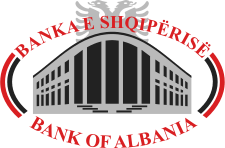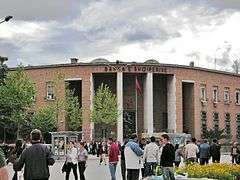Bank of Albania
 | |
| Headquarters | Tirana |
|---|---|
| Established |
2 September 1925[1] [2] |
| Governor | Gent Sejko |
| Central bank of | Albania |
| Currency |
Albanian Lek ALL (ISO 4217) |
| Website | http://www.bankofalbania.org/ |
The Bank of Albania (Albanian: Banka e Shqipërisë) is the central bank of Albania. The Bank of Albania has considerably evolved since being established, in contour with economic, political, and social developments. The main headquarters of the bank is in Tirana. The bank also has five other branches located in Shkodër, Elbasan, Gjirokastër, Korçë, and Lushnjë.
History

The central bank was founded in 1925, and was named the National Bank of Albania until 1944. It was then re-established as the State Bank of Albania, which lasted until 1992 when the Bank of Albania was established. The Bank of Albania now operates as a modern central bank.[3]
Bank overview
The primary goal of the Bank of Albania is to accomplish and sustain price stability. Collaborating with obligations developing from law, the Bank of Albania practices and applies policies of reaching its primary goal of keeping inflation under control. Along with their primary goal, the Bank of Albania promotes and supports the development of the foreign exchange regime and system, the domestic financial market, the payment system, and contributes to improving monetary and lending conditions.[4]
One of the roles of the Bank of Albania is that it acts as manager of the county’s currency by balancing the currency in circulation and credit within the economy. This role is important because allowing too much currency into circulation will end up leading to inflation and allowing less currency in circulation will prevent the economy to grow. As acting currency manager, the Bank of Albania pursues to reach equilibrium between two extremes, which is to promote economic growth by maintaining price stability. [5]
Another role of the Bank of Albania is that it acts as the fiscal agent to the most important client in the country, which is the Albanian Government. Since being the central Bank of Albania, the bank performs a wide range of financial services dealing with billions of Albanian Leks. The Government of Albania keeps an open account with the bank, through which it makes many domestic and international financial transactions. The Treasury operations, which consist of receipts and expenses made by the government is not carried out within the Bank of Albania, but through commercial banks. [6]
Supervisory role
The Bank of Albania is mandated by the Government to supervise and regulate all activity of banks and institutions operating banking activity within the country. The Bank of Albania enforces rules on the establishment of banks and institutions and licenses them. The bank also supervises and monitors all activity of these institutions to ensure that they follow and obey the laws and regulations. [7] The central bank supervises the banking system with the following purposes:
- to promote stability of the banking system and to protect the interests of depositors and the general public;
- to ensure a sound banking system whose activities are transparent to and governed by market economy;
- to provide an environment of confidence for investors and depositors while enabling growth and profitability for the industry.
The role of banking supervision is to promote safety and soundness by:
- ensuring through a licensing process that only fit and proper owners and management, that fulfill the legal, professional and ethical requirements, have the right to enter the banking market; and that they have adequate capital in line with the risks to be undertaken, and have operating policies and procedures to control those risks;
- ensuring that existing banks operate soundly in accordance with law and regulations, have adequate capital and liquidity for foreseeable needs, maintain satisfactory asset quality and adequate resources to offset perceived risks, exercise international standards for best practice in the management of their activities, and conduct their affairs in a manner that is not harmful to clients and general public;
- ensuring that banking problems are resolved quickly and efficiently in a manner that protects depositors to the fullest extent possible, and minimizes the cost to Government and public.
To fulfill this role, banking supervision:
- drafts and revises regulations governing entry to the system, prudential operation of banking activities while in the system, monitors the results achieved, receivership and conservation-ship of banks, and enforces compliance with those laws and regulations;
- establishes pro-active policies and strategies for the supervision of individual banks and the banking system that are based upon an assessment of inherent risks;
- develops supervisory procedures, standards and guidelines that are consistent with international practice;
- implements those procedures, standards and guidelines consistently;
- assures adequacy of staff in terms of number and proficiency to properly supervise the industry;
- sponsors and participates in regular communications with the industry and other supervisors on matters of common interest or concern.
Monetary policy
The monetary policy of the Republic of Albania is an exclusive right of the Bank of Albania. The Policy is designed to achieve the primary goal, to achieve and maintain price stability. The architect of coming up with the policy is based on, the respective legal framework, the academic background employed for modeling and predicting inflation on suitability of the operational target and the set of monetary instruments used to finalize the monetary policy goals. [8] The Bank of Albania is committed to achieving and maintaining annual inflation at 3.0%, with a tolerance band of +/- 1 percentage point. The current annual inflation for the third quarter of 2014 is at 1.7%. [9]
The Bank of Albania manages open market operations through the purchase or sale of securities. These transactions play a main role in the transmission of monetary policy in the banking system. The main reason of using open market operations is the short-term liquidity management of the banking system and trying to stabilize market interest rates.The standing facilities are tools available to banks at their own initiative without restriction under normal circumstances. They consist of tools providing and absorbing overnight liquidity. The interest rates and these tools provide a passage in which the money market interest rates can fluctuate. The minimum reserve requirements serve as a tool targeting at regulating the banking system liquidity and stabilizing the money market interest rates. The amount of minimum reserves to be held by each commercial bank is determined in relation to its reserve base applying the required reserve ratio. This ratio is also the same for the Lek and foreign currency liabilities. The current required ratio is 10 percent. The Bank of Albania’s minimum reserve system allows banks to use the averaging provisions. Banks are allowed to 40 percent if their required reserve. They must show the average of the reserve balance will not be less than the reserve requirement by the end of the maintenance period. Required reserves denominated in the Albanian currency are reimbursed at a rate derived from the base rate, while holdings of required reserves in foreign currency are also reimbursed at a rate derived from the base rate of the European Central Bank and Federal Reserve. [10]
Governors
The Governors after 1992 have been:[11]
- Prof. Assoc. Dr. Ilir Hoti (May 1992 - September 1993)
- Dylber Vrioni (September 1993 - December 1994)
- Kristaq Luniku (December 1994 - April 1997)
- Qamil Tusha (April 1997 - August 1997)
- Prof. Dr. Shkëlqim Cani (August 1997 - October 2004)
- Ardian Fullani (October 2004 - September 2014)[12]
- Elisabeta Gjoni (Interim) (September 2014 - February 2015)[13] [14]
- Gent Sejko (February 2015 - present)
See also
- Economy of Albania
- Albanian lek
- Monetary Gold Removed from Rome in 1943 (Italy v. France, United Kingdom and United States)
References
- ↑ "A brief history of central banking in Albania". Bank of Albania. Retrieved 29 July 2016.
- ↑ "Archived copy". Archived from the original on 2007-10-12. Retrieved 2011-01-01.
- ↑ Bank of Albania (n.d.). "A brief history of the Bank of Albania". bankofalbania.org. Bank of Albania. Retrieved 26 November 2014.
- ↑ Bank of Albania (n.d.). "Main Objective". bankofalbania.org. Bank of Albania. Retrieved 26 November 2014.
- ↑ "Manager of The National Currency". 2004. Retrieved November 23, 2014.
- ↑ "BoA-Fiscal Agent." Www.bankofalbania.com. N.p., 2004. Web. 23 Nov. 2014. <http://www.bankofalbania.org/web/BoA_fiscal_agent_88_2.php?evn=link_Me&evb=middle>.
- ↑ "Supervisor and Regulator." Www.bankofalbania.com. N.p., 2004. Web. 23 Nov. 2014. <http://www.bankofalbania.org/web/supervisor_and_regulator_89_2.php?evn=link_Me&evb=middle>.
- ↑ "Monetary Policy." Www.bankofalbania.org. N.p., 2004. Web. 23 Nov. 2014. <http://www.bankofalbania.org/web/Monetary_Policy_8_2.php>
- ↑ Albania, Bank Of. Monetary Policy Report 2014 Q3. Tirana: Bank of Albania, Oct. 2014. PDF.
- ↑ "Operational Framework of Bank of Albania." Www.bankofalbania.org. N.p., 2004. Web. 23 Nov. 2014. <http://www.bankofalbania.org/web/Monetary_Instruments_10_2.php>.
- ↑ The Governor of the Bank of Albania, Bank of Albania
- ↑ http://www.bankofalbania.org/web/BANK_OF_ALBANIA_7127_2.php?kc=0,26,0,0,0
- ↑ http://www.bankofalbania.org/web/cv_Gjoni_ang_6651_2.php
- ↑ https://www.reuters.com/article/2014/09/07/albania-cenbank-sacking-idUSL5N0R80L420140907
The Bank of Albania Retrieved on 01-03-2009.
